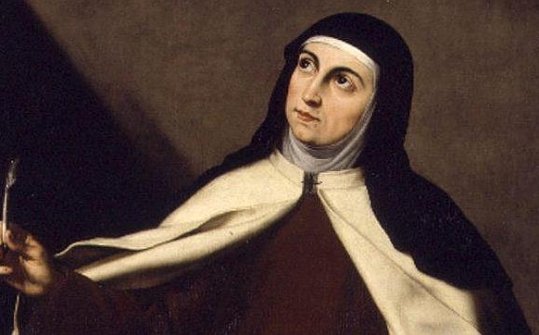Organised in connection with the 5th Centenary of the Birth of Saint Teresa of Jesus, the aim of this exhibition is to explore the meaning of spiritual searches at the onset of the third millennium, establishing the need to find their common anthropological thread and endorsing their connection with creative languages.
The exhibition title Fear Nothing, She Says. When Art Reveals Mystic Truths revises the verse by Teresa of Jesus, transforming 'Let nothing perturb you, nothing frighten you,' into the simpler 'fear nothing', which it relates to the novel Détruire, dit-elle by Marguerite Duras, another great authoress and sufferer for love. The afterthought 'she says' reaffirms the fact that the invitation to overcome obstacles and fears is conveyed in the words of a woman, and therefore opens up to the new developments of global ethical and aesthetic awareness that demands, as Saint Teresa herself often did, the inclusion of women as subjects of knowledge and power.
The twenty-one contemporary artists have been chosen for their thematic, conceptual, existential or political affinities with the figure and the legacy of Teresa of Avila: Marina Abramovic, Anila Quayyum Agha, José Ramón Ais, Pilar Albarracín, Francis Alÿs, Miquel Barceló, Louise Bourgeois, Dora García, Anish Kapoor, Waqas Khan, Kimsooja, Cristina Lucas, Bruce Nauman, Nikos Navridis, Rivane Neuenschwander, Cai Guo-Qiang, Eglė Rakauskaitė, Soledad Sevilla, Josefa Tolrà, Eulalia Valldosera and Bill Viola. Works designed specifically for the show complement others that coexist with unique pieces from the museum's historical collections.
The Museo Nacional de Escultura has three buildings located on the same street: the Colegio de San Gregorio, founded as a school of theology in the fifteenth century, and two noble residences of the sixteenth century, the Palacio de Villena and the Casa del Sol. In these spaces the exhibition itinerary explores the symbiotic relationships between memory and new forms of aesthetic enjoyment. Such critical interaction extends to nearby Coco Café, where the spheres of public and private, civic and institutional associations are connected. The four venues form a constellation that establishes intertextual dialogues and updates the significance of material, linguistic and ideological quests.
The digital version of the catalogue will be avaliable for downloaded in our web under a Creative Commons licence: http://www.accioncultural.es/en/ebooks
The exhibition title Fear Nothing, She Says. When Art Reveals Mystic Truths revises the verse by Teresa of Jesus, transforming 'Let nothing perturb you, nothing frighten you,' into the simpler 'fear nothing', which it relates to the novel Détruire, dit-elle by Marguerite Duras, another great authoress and sufferer for love. The afterthought 'she says' reaffirms the fact that the invitation to overcome obstacles and fears is conveyed in the words of a woman, and therefore opens up to the new developments of global ethical and aesthetic awareness that demands, as Saint Teresa herself often did, the inclusion of women as subjects of knowledge and power.
The twenty-one contemporary artists have been chosen for their thematic, conceptual, existential or political affinities with the figure and the legacy of Teresa of Avila: Marina Abramovic, Anila Quayyum Agha, José Ramón Ais, Pilar Albarracín, Francis Alÿs, Miquel Barceló, Louise Bourgeois, Dora García, Anish Kapoor, Waqas Khan, Kimsooja, Cristina Lucas, Bruce Nauman, Nikos Navridis, Rivane Neuenschwander, Cai Guo-Qiang, Eglė Rakauskaitė, Soledad Sevilla, Josefa Tolrà, Eulalia Valldosera and Bill Viola. Works designed specifically for the show complement others that coexist with unique pieces from the museum's historical collections.
The Museo Nacional de Escultura has three buildings located on the same street: the Colegio de San Gregorio, founded as a school of theology in the fifteenth century, and two noble residences of the sixteenth century, the Palacio de Villena and the Casa del Sol. In these spaces the exhibition itinerary explores the symbiotic relationships between memory and new forms of aesthetic enjoyment. Such critical interaction extends to nearby Coco Café, where the spheres of public and private, civic and institutional associations are connected. The four venues form a constellation that establishes intertextual dialogues and updates the significance of material, linguistic and ideological quests.
The digital version of the catalogue will be avaliable for downloaded in our web under a Creative Commons licence: http://www.accioncultural.es/en/ebooks





